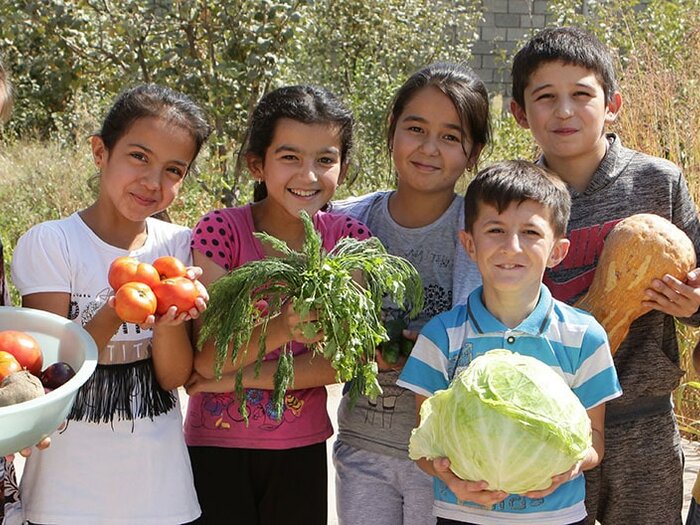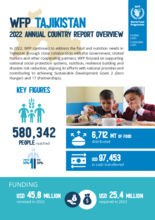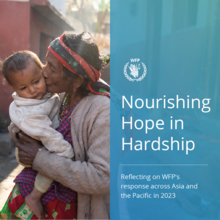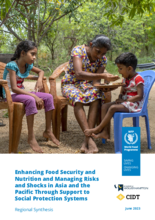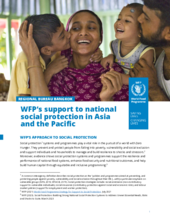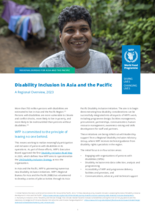Tajikistan
- 47%
- of people live on less than US$1.33 a day
- 30.1%
- of people are undernourished
- 9.1 million
- population
Tajikistan, a landlocked country of 9.1 million people, faces continuing food-security challenges—its rates of malnutrition rates remain the highest in Central Asia, despite lowering over the past 10 years.
The country is also the most vulnerable to climate shocks in the region.
Soil erosion, loss of biodiversity, melting glaciers and extreme weather events—such as floods, droughts, avalanches and landslides—regularly destroy land, crops, infrastructures, and livelihoods. For this reason, half of Tajikistan’s food is imported, with fluctuations in food prices disproportionally affecting the poorest people and reducing their buying power.
Mountains cover 93 percent of Tajikistan’s territory. The remaining 7 percent is arable land but 97 percent of it is subject to soil degradation.
Tajikistan is gradually recovering from an economic shock that began in late 2014. However, despite progress in poverty reduction, recent economic challenges compounded by population growth have contributed to an increase in the vulnerability of households to food insecurity.
What the World Food Programme is doing in Tajikistan
-
COVID-19 response
-
WFP supports vulnerable households in Tajikistan that have been socially and economically impacted from COVID-19. Among them, WFP prioritizes those families that are chronically food insecure and rely mainly on remittances sent from their family members working abroad. Around 3,000 community members will be involved in public works through conditional cash transfers. The initiative is expected to assist about 15,000 people to cope with the shocks while setting the basis for the improvement of their livelihood in the medium-term.
-
School feeding
-
Since 1999, WFP has partnered with the Government of Tajikistan to deliver school feeding—its largest operation in the country. In 2019, daily school meals were supplied to more than 400,000 schoolchildren across 2,000 schools in 52 rural districts. Providing food to children at school every day can mean not only better nutrition and health, but also increased access to and achievement in education. It also gives parents a strong incentive to consistently send children to school.
-
Nutrition
-
Working closely with Tajikistan’s Ministry of Health and Social Protection of the Population, UNICEF and WHO, WFP assists parents and health centres responding to moderate acute malnutrition (MAM). In 2019, WFP treated over 8,000 children for MAM through a supplementary feeding programme, offering mainly fortified cereals, in more than 200 primary healthcare centres. A pilot rollout included the Balkhi, Shahrituz, Kulob, Dusti districts of Khatlon Region and the Ayni District of Sughd Region.
-
Food assistance for assets
-
Communities receive cash transfers for working on labour-intensive activities on community assets such as irrigation systems, soil conservation and regeneration, drinking water supplies and the construction of bridges, roads and other critical infrastructure. These reduce the risk of disaster, strengthen livelihoods and build climate resilience. WFP is also providing Food Assistance for Training to enable the transfer of skills and to further build self-reliance.
-
Emergency response and preparedness
-
WFP provides policy advice, technical assistance and capacity and systems strengthening to key public institutions and private sector stakeholders, such as the Committee for Emergency Situations and Civil Defence, the Ministry of Health and Social Protection of the Population, the Ministry of Education and Science, the Chamber of Commerce, and other relevant agencies, in line with SDG 17.
Tajikistan news releases
Go to pagePartners and donors
Find out more about the state of food security in Tajikistan
Visit the food security analysis pageOperations in Tajikistan
Contacts
Office
5, Lohuti Street, Proezd 1
Dushanbe 734013
Tajikistan

